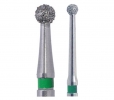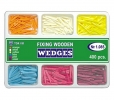A new flash-free orthodontic adhesive system: A first clinical and stereomicroscopic study
OBJECTIVE
To analyze the clinical and laboratory properties of the recently introduced APC flash-free orthodontic adhesive
MATERIAL AND METHODS
After bonding of 80 brackets on human teeth (group A: APC flash-free adhesive n = 40, group B: APC Plus adhesive n = 40), the following measurements were recorded: time for bonding, stereomicroscopic evaluation of excess adhesive, color penetration (methylene blue, 0.5%/24 h), and Adhesive Remnant Index (ARI) score after debonding
RESULTS
The time needed for bonding differed significantly between the two groups (A: 19.5 s/tooth vs B: 33.8 s/tooth). The adhesive excess, which was metrically measured from the bracket edge, ranged from 166.27 µm to 81.66 µm (group A) and 988.53 µm to 690.81 µm (group B). After methylene coloration in group A, 52 of 80 measurements showed discoloration on the bracket-adhesive and/or adhesive-enamel interface, while for group B, 78 of 80 were coloration positive. The ARI scores did not differ, with an average ARI score of 2.0 for group A and 2.8 for group B
CONCLUSION
The flash-free adhesive significantly reduced the time needed for the bonding process. The excess resin expanded 0.16 to 0.08 mm over the bracket margin. The new technology seems to facilitate a smooth and sufficient marginal surface of the adhesive, which clinically might improve reduction of plaque accumulation
Source: PMID: 26258897 PubMed - as supplied by publisher
Date of publish: 2015 Aug 10





